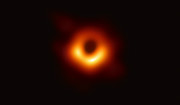Mededeling
Breakthrough Prize in Fundamental Physics awarded to the Event Horizon Telescope Collaboration
9 september 2019
The Event Horizon Telescope (EHT) Collaboration, the team who captured an image of a black hole for the first time, has been awarded the 2020 Breakthrough Prize in Fundamental Physics in recognition of this achievement. The feat used an Earth-scale array of eight ground-based radio telescopes, including two in which ESO is a major partner: the Atacama Large Millimeter/submillimeter Array (ALMA) and the Atacama Pathfinder Experiment (APEX). Three current and recent ESO employees are among the scientists who will share in the prize.
The ALMA and APEX telescopes [1][2] location in Chile were indispensable in achieving the unprecedented resolution required for this breakthrough. The large combined collecting area of ALMA's antennas also made it the most sensitive facility in the EHT by far, and a key part of the entire network, enabling the EHT to capture ten times fainter signals.
The Breakthrough Prize Foundation and its founding sponsors — Sergey Brin, Priscilla Chan and Mark Zuckerberg, Ma Huateng, Yuri and Julia Milner, and Anne Wojcicki — announced the award on 5 September 2019. Collaboration Director Shep Doeleman, of the Harvard-Smithsonian Center for Astrophysics, will accept the prize on behalf of the collaboration at a ceremony on 3 November 2019. The $3 million prize will be shared equally with 347 scientists co-authoring any of the six papers published by the EHT collaboration on 10 April 2019.
Among the prize recipients are Neil Phillips, ALMA Instrument Scientist at ESO, Rubén Herrero-Illana, an ESO Fellow with duties at ALMA, and Hugo Messias, who until recently was an ALMA Fellow employed by ESO.
The EHT image, which achieved worldwide fame after it was unveiled by the collaboration on 10 April 2019, reveals the black hole at the centre of Messier 87, a massive galaxy in the nearby Virgo galaxy cluster. This black hole resides 55 million light-years from Earth and has a mass 6.5 billion times that of the Sun.
Notes
[1] ALMA is a partnership of ESO, the U.S. National Science Foundation (NSF) and the National Institutes of Natural Sciences (NINS) of Japan in cooperation with the Republic of Chile. ALMA is funded by ESO on behalf of its Member States, by NSF in cooperation with the National Research Council of Canada (NRC) and the National Science Council of Taiwan (NSC) and by NINS in cooperation with the Academia Sinica (AS) in Taiwan and the Korea Astronomy and Space Science Institute (KASI).
[2] APEX is a collaboration between the Max Planck Institute for Radio Astronomy, the Onsala Space Observatory and ESO, and is operated by ESO close to ALMA on the Chajnantor Plateau in Chile’s Atacama region.
Links
- Breakthrough Prize 2020 Official Announcement
- Press Release on First Ever Image of a Black Hole
- ESOBlog interview with Rubén Herrero-Illana and Hugo Messias
Contact
Mariya Lyubenova
ESO Head of Media Relations
Garching bei München, Germany
Tel: +49 89 3200 6188
Email: pio@eso.org
Over de Mededeling
| Id: | ann19043 |


